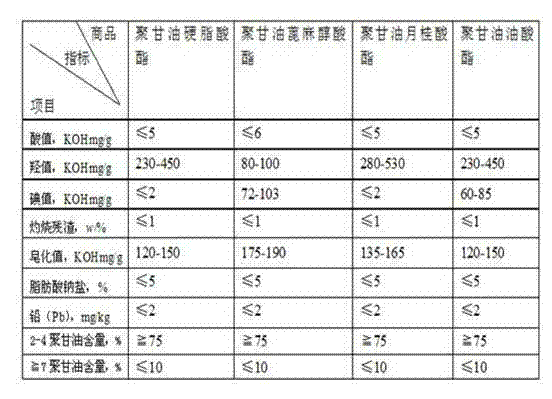Refining method for polyglycerin and polyglycerin fatty acid ester
A technology for polymerizing glycerol and fatty acid ester, applied in the field of food additives, can solve the problems of difficult to guarantee food safety, high content of unreacted glycerin, irritating odor, etc., to meet food safety requirements, improve food safety, and have no The effect of pungent odors
- Summary
- Abstract
- Description
- Claims
- Application Information
AI Technical Summary
Problems solved by technology
Method used
Image
Examples
Embodiment 1
[0021] Put 1000Kg of measured glycerin into the reaction kettle, add basic catalyst (potassium hydroxide), heat to 250-265°C, react under nitrogen protection for 16-18 hours, measure the hydroxyl value to control the reaction end point. Then cool down to 120-130°C under vacuum, let about 870Kg of the material enter the first wiped film evaporator, evaporate about 50Kg of unreacted glycerin (light phase 1) at 140-150°C, and then make about 820Kg of the heavy phase material into short-path distillation At 200-230°C, 40-45pa distill out two to four polyglycerols about 700Kg (light phase two), and the heavy phase material enters the second short-path distiller at 240-250°C, 0-5pa to further distill four To about 100Kg of hexapolyglycerol (light phase 3), collect light phase 2 and light phase 3 and mix, measure a total of 800Kg of mixed polyglycerol and put it into the esterification reactor again, and at the same time, measure 1400Kg of stearic acid, and then add the catalyst (Sod...
Embodiment 2
[0023] Put the measured glycerol 1000Kg into the reaction kettle, add the basic catalyst (potassium hydroxide), heat to 240-250°C, react under the protection of nitrogen for 18-20 hours, measure the hydroxyl value to control the reaction end point. Then cool down to 110-120°C under vacuum, let about 870Kg of the material enter the first wiped film evaporator, evaporate about 50Kg of unreacted glycerin (light phase 1) at 130-140°C, and then put about 820Kg of the heavy phase into short-path distillation Distiller at 220-230°C, 20-40pa to distill about 700Kg of two to four polyglycerols (light phase two), and the heavy phase material enters the second short-path distiller at 245-250°C, 3-5pa to further distill four To about 100Kg of hexapolyglycerol (light phase 3), collect light phase 2 and light phase 3 and mix, measure a total of 800Kg of the mixed polyglycerol and put it into the esterification reactor again, and at the same time, measure 1450Kg of phosphoric acid and ricinol...
Embodiment 3
[0025] Put 1000Kg of measured glycerin into the reaction kettle, add basic catalyst (sodium hydroxide), heat to 250-265°C, react under nitrogen protection for 16-18 hours, measure the hydroxyl value to control the reaction end point. Then cool down to 120-130°C under vacuum and put about 870Kg of the material into the first wiped film evaporator, evaporate about 50Kg of unreacted glycerin (light phase 1) at 130-140°C, and then put about 820Kg of the heavy phase into short-path distillation At 180-220°C, 40-50pa distill out two to four polyglycerols about 700Kg (light phase two), and the heavy phase material enters the second short-path distiller at 200-240°C, 0-5pa to further distill four To about 100Kg of hexaglycerol (light phase 3), collect light phase 2 and light phase 3 and mix, measure 800Kg of polyglycerin mixed and put it into the esterification reactor again, simultaneously measure 1000Kg of lauric acid, and then add catalyst ( Sodium hydroxide) at 160-180 ° C, carry ...
PUM
 Login to View More
Login to View More Abstract
Description
Claims
Application Information
 Login to View More
Login to View More - R&D
- Intellectual Property
- Life Sciences
- Materials
- Tech Scout
- Unparalleled Data Quality
- Higher Quality Content
- 60% Fewer Hallucinations
Browse by: Latest US Patents, China's latest patents, Technical Efficacy Thesaurus, Application Domain, Technology Topic, Popular Technical Reports.
© 2025 PatSnap. All rights reserved.Legal|Privacy policy|Modern Slavery Act Transparency Statement|Sitemap|About US| Contact US: help@patsnap.com

